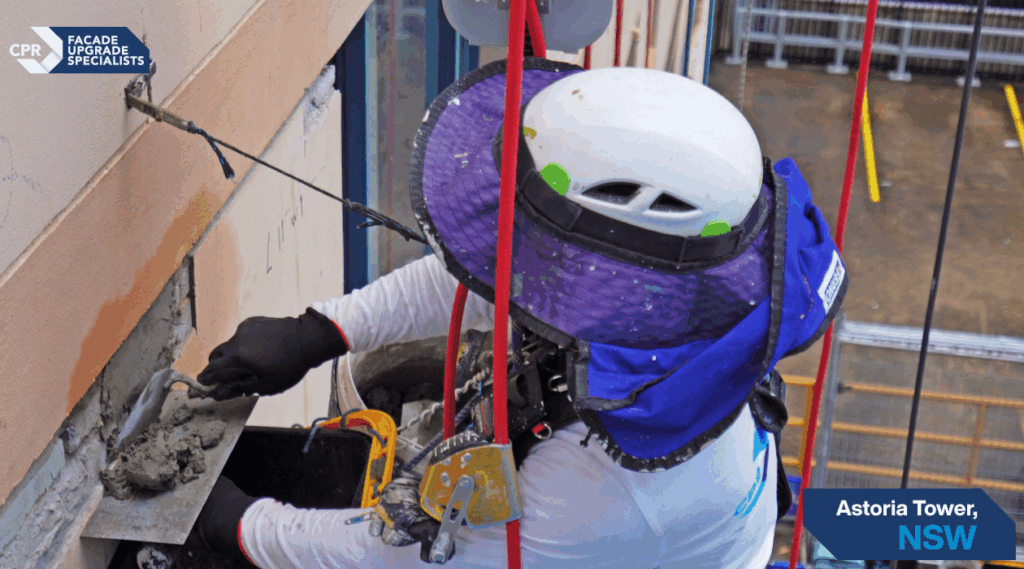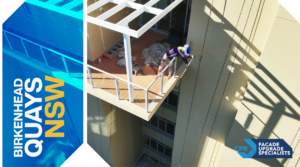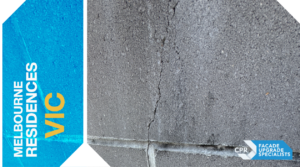Concrete cancer is a serious issue for many Australian buildings, particularly high-rise and difficult-to-access structures. Known technically as spalling concrete or reinforced concrete corrosion, it occurs when steel reinforcement within the concrete begins to rust. This rust expands, causing cracks, surface flaking, and in advanced cases, major structural damage. If left untreated, concrete cancer can compromise the safety of occupants, dramatically increase repair costs, and reduce property value.
Early detection and effective treatment are essential. At CPR, we specialise in Scaffold-Free™ remediation powered by patented systems like MARS™, PEARS®, and SkyPod®. Combined with SKY-FIMMS™, our advanced digital inspection and reporting platform, we provide multi-decade solutions with minimal disruption, full transparency, and significant cost savings—which means for you, peace of mind and financial security.
What is Concrete Cancer?
Concrete cancer is often called the “cancer” of buildings because, like its namesake, it spreads and worsens over time if not addressed. It occurs when embedded steel reinforcement corrodes, forcing the surrounding concrete to crack and deteriorate.
Common structures affected include:
- High-rise residential towers
- Strata complexes
- Commercial buildings
- Government and heritage properties exposed to weather and salt air
For strata committees, concrete cancer represents a direct threat to property value. For building managers and consultants, it signals urgent structural concerns requiring technical expertise.
Early Symptoms of Concrete Cancer
Identifying concrete cancer early can prevent costly repairs. Warning signs include:
- Cracking surfaces – fine hairline cracks or larger fractures on concrete elements.
- Rust stains or bubbling paint – brown streaks or paint bubbling over concrete surfaces.
- Spalling concrete – flaking, chipping, or crumbling patches.
- Exposed reinforcement bars – visible rusted steel poking through broken concrete.
- Leaks or dampness – water ingress through walls or ceilings that indicates concrete deterioration.
These are not just cosmetic issues—they are signs of deeper structural damage.
Causes of Concrete Cancer
Several factors contribute to concrete cancer:
- Water ingress and poor waterproofing – moisture penetration accelerates corrosion.
- Steel reinforcement corrosion – when steel rusts, it expands up to seven times its size, fracturing the surrounding concrete.
- Poor concrete mix or construction practices – substandard materials shorten the lifespan of structures.
- Harsh environmental conditions – salt air, humidity, or freeze-thaw cycles in exposed locations.
- Neglected maintenance – unresolved leaks and cracks allow damage to spread.
For building managers and consultants, understanding these causes is key to designing preventative solutions.
Risks of Untreated Concrete Cancer
Ignoring concrete cancer has severe consequences:
- Compromised structural integrity – weakening of beams, slabs, and columns.
- Safety hazards – falling concrete poses risks to occupants and pedestrians.
- Escalating costs – what starts as minor spalling can evolve into a multi-million-dollar repair project.
- Reduced property value – visible deterioration deters buyers and tenants.
- Legal liabilities – strata committees and building owners may be held accountable for neglect.

Concrete Cancer Treatment & Repair Options
At CPR, we combine expert diagnosis with Scaffold-Free™ repair methods:
- Professional inspection & diagnosis – SKY-FIMMS™ delivers a precise 3D digital twin of your facade, identifying every defect with photographic proof.
- Concrete patch repair & resurfacing – addressing spalling areas before damage spreads.
- Reinforcement bar treatment or replacement – removing rust and protecting steel from future corrosion.
- Waterproofing membranes & sealants – preventing water ingress and future deterioration.
- Protective coatings – sealing and preserving repaired surfaces for decades.
Our SkyPod® encapsulated workstations ensure safe, dust-controlled, and quiet repairs, which means for you minimal disruption and cleaner living conditions.
Prevention: How to Protect Buildings from Concrete Cancer
Concrete cancer is preventable with the right strategies:
- Regular building inspections – using SKY-FIMMS™ for ongoing monitoring.
- Waterproofing solutions – proactive application to roofs, balconies, and external walls.
- Proper drainage systems – ensuring water is diverted away from concrete surfaces.
- High-quality materials – ensuring longevity from the start.
- Scheduled maintenance – AssetCare™ programs deliver multi-decade solutions, reducing long-term costs.
Concrete Cancer vs. Other Building Defects
Not all cracks are concrete cancer. Settlement cracks or surface wear may mimic it, but without expert inspection it’s impossible to know. SKY-FIMMS™ provides data-backed clarity, removing guesswork.
FAQs About Concrete Cancer
Can concrete cancer be stopped completely?
Yes—with professional treatment and preventive maintenance, deterioration can be halted and controlled.
How long do repairs last?
With Scaffold-Free™ remediation and AssetCare™, CPR’s solutions last decades, unlike quick fixes that fail in a few years.
Is it safe to live in a building with concrete cancer?
It depends on severity. Minor cases pose low risk, but advanced spalling can endanger residents. Always seek professional assessment.
How much does concrete cancer repair cost?
Costs vary. Scaffold-Free™ systems typically save up to 30% compared to scaffolding, meaning more affordable, efficient outcomes.
Case Studies / Real-Life Examples
Residential high-rise in Sydney: SKY-FIMMS™ identified 1,200 defects. Using SkyPod® systems, CPR completed works in 3 months instead of 6, saving the strata committee $750,000.
Commercial property in North Sydney: Advanced spalling repairs were completed without scaffolding. Minimal disruption meant tenants operated as usual.
The Cost of Ignoring Concrete Cancer
Delaying repairs can multiply costs by five to ten times. Short-term savings are quickly eclipsed by long-term losses. Preventive remediation is always more affordable.
Get Professional Help for Concrete Cancer Repairs
Concrete cancer requires more than a patch job—it needs expert inspection, advanced technology, and long-term care. At CPR, we provide transparency, safety, and proven results.






